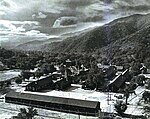California's 28th congressional district

California's 28th congressional district is a congressional district in the U.S. state of California, in Los Angeles County. The district is regarded as a Democratic stronghold and has been held by the Democratic Party since 2003 and is currently represented by Democrat Judy Chu. Follow redistricting in ahead of the 2022 election cycle, the 18th district was relocated to the San Gabriel Valley. Formerly, from 2003 to 2013, the district included about half of the San Fernando Valley, including North Hollywood, in the Greater Los Angeles Area. Due to redistricting after the 2010 United States Census, the district shifted east within Los Angeles County and includes portions of Burbank and Glendale.
Excerpt from the Wikipedia article California's 28th congressional district (License: CC BY-SA 3.0, Authors, Images).California's 28th congressional district
Valaho Drive, Los Angeles Tujunga
Geographical coordinates (GPS) Address Nearby Places Show on map
Geographical coordinates (GPS)
| Latitude | Longitude |
|---|---|
| N 34.25 ° | E -118.29138888889 ° |
Address
Valaho Drive 7313
91042 Los Angeles, Tujunga
California, United States
Open on Google Maps





